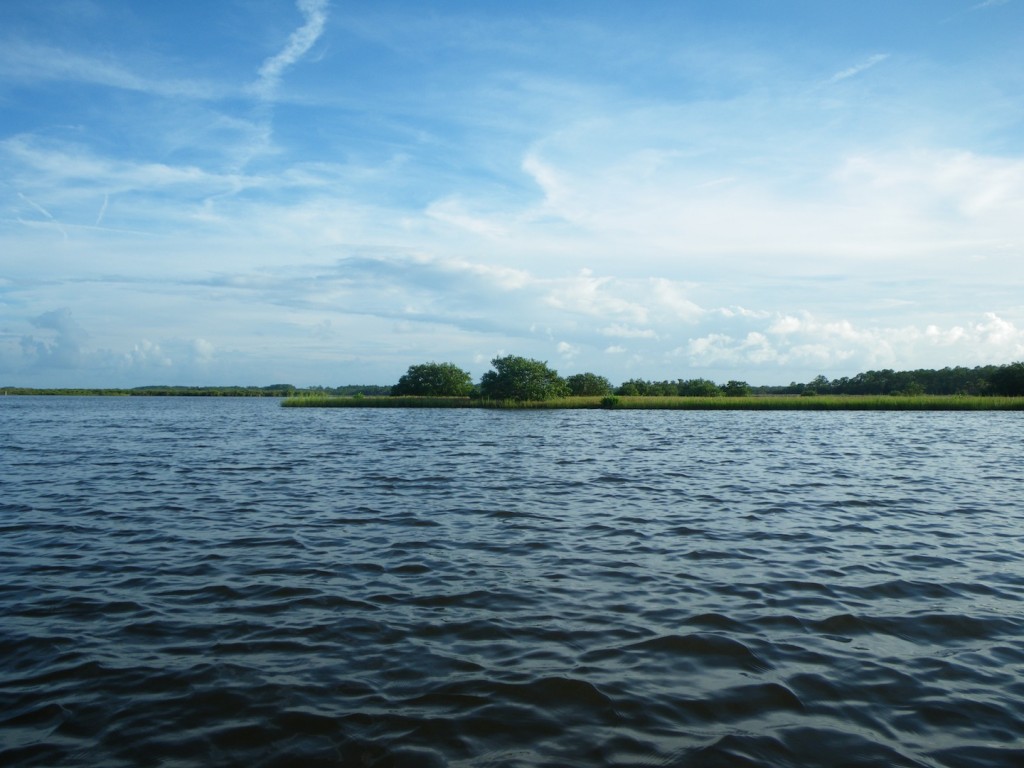by Mayda Nathan

Many insects visit black mangrove flowers, including bumblebees (left) and Pseudomyrmex ants (right). But which pollinators are the most important? (Mayda Nathan)
But how can we make predictions about invaders that are…native?
In other words, what happens when an organism starts to spread out from its native range into adjacent territory—without hitchhiking along with humans? And why does this happen in the first place?
This is the conundrum facing researchers who study shifting species distributions, and it’s the impetus behind our work in the mangroves and marshes of Florida’s Atlantic coast. Here, mangroves are encroaching on grassy salt marshes, moving northward and transforming the coastal landscape as they go. Within a few decades, areas that were once almost entirely marsh have become thick with mangroves. Our team is interested in what makes the mangroves such good invaders, and in the ecological consequences of this change.

Mangroves are expanding their range northward into salt marsh along the Florida coasts.
(Cora Johnston)
First of all, black mangroves are the most cold-tolerant of Florida’s three mangrove species, and they form the vanguard of the moving mangrove front. In the marshes just north of St. Augustine, Fla., the scattered, shrubby trees you’ll find growing among the cordgrass and saltwort are all black mangroves. We’ve been amazed to see that despite their presumably young age, these trees at the extreme edge of their range are putting a lot of effort into reproduction. If black mangroves are going to continue spreading north, they’ll need to successfully reproduce and disperse their offspring. This depends on pollination.
Another reason for studying black mangrove pollination is that how black mangroves reproduce—their “mating system”—is dramatically different from the mating system of the marsh grasses they’re displacing. The north Florida marshes are dominated by smooth cordgrass, Spartina alterniflora. Like most grasses, cordgrass is wind-pollinated. In the fall, cordgrass sends up feathery stalks of green-brown flowers and lets the wind do its work.

Close-up of a butterfly proboscis (feeding tube). The white specks on the curled proboscis are black mangrove pollen grains.
(Mayda Nathan)
Which species are the most important pollinators for black mangroves? Which species are cheating the system by taking nectar without transporting pollen? (Ants, I’m looking at you.) And are the black mangrove flowers drawing species out to the marshes that wouldn’t otherwise come? How much of the change in community composition can we attribute to this new floral resource?
Finally, there’s a reason to monitor mangrove pollen movement and pollinator activity that ecologists have only recently begun to explore: genetic diversity. If we decide to monitor ecological interactions in a meadow, for example, we know it matters that daisies are different from primroses. But how much does it matter if individual primroses are different from each other?
This boils down to genetic diversity—how related the primroses (or daisies, or black mangroves) are to one another. It turns out that incredibly fundamental ecosystem properties like primary production, rates of herbivory, resource use, and time to recovery after a disturbance can depend on genetic diversity. And if black mangrove genetic diversity shapes the mangrove stands that are cropping up in Florida’s salt marshes, then the amount of genetic mixing—through pollen flow—matters a lot.

Attaching a mesh bag to a black mangrove flowerhead can tell us how well black mangroves can reproduce if large pollinators are blocked from their flowers. (Mayda Nathan)
More stories from the mangroves >>
This material is based upon work supported by the National Science Foundation under Grant Number 1065098. Any opinions, findings, and conclusions or recommendations expressed in this material are those of the author(s) and do not necessarily reflect the views of the National Science Foundation.


How very intersting and fascinating, Mayda. You are a good writer and scientist as well as a researcher. Love, Irene O.
Fascinating research area and timely as we look for reforestation candidates in the face of global climate change. Could this be an efficient carbon sink?